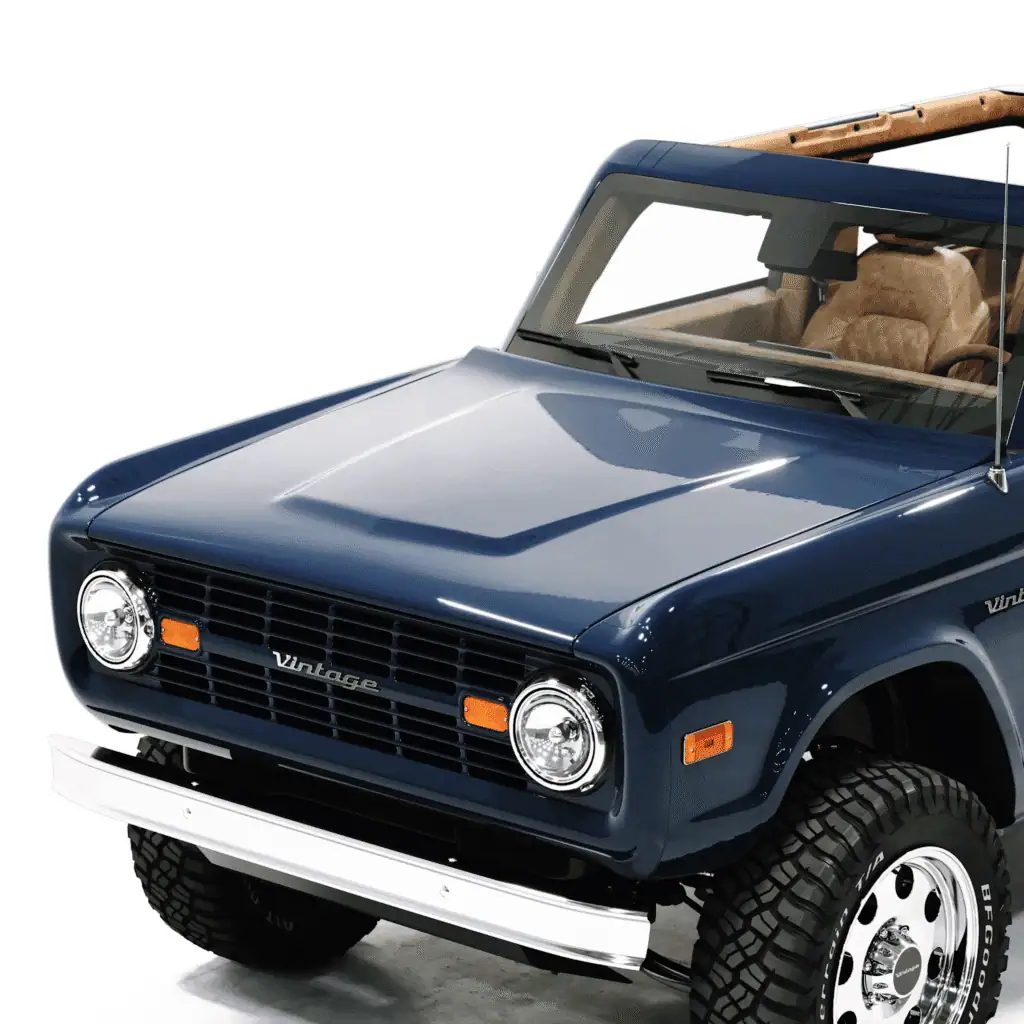Introduced in the mid-1960s, the Ford Bronco wasn’t just another 4×4; it was a bold, boxy, clean-sheet build machine that redefined what a utility vehicle could be. With its compact size, trail-ready capability, and no-nonsense design, it carved out a new category and helped shape the SUV as we know it.
While Vintage Modern is not affiliated with Ford, we were inspired by the Ford Bronco history.
So let’s take a respectful, fact-based look at the vehicle that helped define the early SUV movement and inspired an entirely new generation of retro-modern design.
The Beginning: 1966 – The First Generation

Image credit: Ford.com
A New Kind of Off-Roader
The Bronco debuted in August 1965 as a 1966 model, designed to fill a gap that no other vehicle at the time quite addressed. On one end were rugged, military-inspired 4x4s like the Jeep CJ, built for toughness, not comfort. On the other hand were traditional passenger cars, refined but limited once the pavement ended. The Bronco aimed to do both: offer everyday drivability with true off-road grit.
Internally, the project was code-named “G.O.A.T.” — Goes Over Any Terrain; a phrase that not only captured its mission but eventually became part of off-road culture itself.
Key Traits of the Early Model
- 92-inch short wheelbase for tight maneuvering
- Removable hardtop for open-air flexibility
- Simple, functional cabin with utilitarian charm
- Optional inline-six or V8 engine
- Basic leaf-spring suspension designed for durability
It was among the first to be described as a sport utility vehicle, long before “SUV” became a mainstream term.
Position in the Market
At launch, the Bronco went head-to-head with the Jeep CJ-5 and the International Harvester Scout, two of the most rugged 4x4s of the time, which people often get confused given their similar design. But while those vehicles leaned heavily into utilitarian, no-frills performance, the Bronco brought a smoother, more car-like ride that didn’t compromise its ruggedness.
That mix of comfort and capability made it a revolution in its own right, bringing 4×4 performance to everyday roads.
1970s: Evolving with the Market
Listening to Consumers
As the off-road market matured, so did expectations. Drivers wanted more power, smoother suspension, and comfort for both work and play. By 1973, optional power steering and automatic transmission were introduced to meet those needs.
By the end of the first-gen run in 1977:
- A 302-cubic-inch V8 had become the standard engine
- Front disc brakes and optional power brakes added safety
- New trim levels made the Bronco more approachable to suburban buyers
1980s–1990s: A New Direction

Image credit: corporate.ford.com
A Bigger Platform, A Broader Market
In 1978, the Bronco transitioned to a full-size SUV using a shortened F-Series truck chassis. This new version was larger, more powerful, and aimed squarely at families who needed towing power and passenger space, without sacrificing off-road credibility.
Notable upgrades included:
- Improved four-wheel drive systems
- Enhanced suspension for better road comfort
- Towing capacity up to 7,000 lbs
- Features like air conditioning, cruise control, and plush interiors
End of the Line (for a While)
Production ended in 1996, driven by changing consumer preferences toward four-door SUVs and modern safety regulations. The Explorer and Expedition took their place in Ford’s lineup.
Prices for early models rose, collectors swooped in, and custom shops gave the old 4x4s new life.
What the Bronco Legacy Represents Today
A Symbol of Off-Road Heritage
Whether you’re looking at a vintage ad or an original build on the trail, the Bronco represents a time when SUVs were simpler, more rugged, and built with intent. The Ford Bronco history timeline doesn’t just tell the story of a vehicle; it tells the story of an automotive shift.
A Legacy That Inspired the Modern Classic Movement

At Vintage Modern, we recognize the influence of vehicles from that era. We’re inspired by what they represented: independence, grit, and timeless appeal, and we’ve taken those values into the future with our Modern Classics.
Built New. Styled with Intention.
Our Modern Classics are designed from a clean slate, blending timeless proportions with modern engineering where it matters most. Each vehicle is constructed using premium materials, equipped with advanced safety systems, and shaped by a design philosophy that respects the past while living in the present.
We study the old classics and what made them iconic and then refine them for today’s roads, expectations, and standards.
These are not restorations or restomods. They’re purpose-built machines that carry the spirit of the vintage era without any of the mechanical baggage.
For People Who Love the Past, But Demand More
You shouldn’t have to choose between form and function. Or style and substance. Or character and comfort. With our builds, you don’t.
You get the unmistakable build of a classic-inspired SUV, paired with the smooth ride, safety features, and technology today’s roads demand. It’s the best of both eras, without the compromises of either, because honoring the past doesn’t mean living in it.
It means knowing where you come from and building something bold enough to carry that story forward.
Conclusion
The history of the Ford Bronco is rich with innovation, rugged charm, and cultural impact. It was a vehicle that helped define a segment and sparked a movement that still resonates with drivers today.
At Vintage Modern, we honor that legacy by building something new: vehicles inspired by that era’s boldness, elevated with modern engineering and luxury craftsmanship.
They’re not restorations but precision-crafted Modern Classics by Vintage, made for those who respect where off-road started, and know exactly where they’re headed.
Ready to experience it for yourself? Explore our builds or contact our team today.